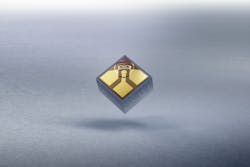When Heiko Krebs, senior vice president of product management at SICK (Waldkirch, Germany), reached out to Ralph Gudde, vice president marketing and sales for TRUMPF Photonic Components (formerly Philips Photonics; Ulm, Germany), he was interested in collaborating on a technically innovative optical sensor for industrial plants.
Specifically, Krebs wanted to establish a new technology in the world’s conveyor systems: noncontact optical capture of production data such as speed, position, or length. The reason? Until now, these were much more expensive than standard measuring wheel encoders, which involve a wheel rolling over the passing goods and components and calculating their dimensions and speed. “The benefits of noncontact measurement would usually not outweigh the higher purchase price,” says Krebs.
SICK’s customers come from all sectors, because industrial companies everywhere want to automate their process and production systems, which requires reliable, real-world data from their systems to control their processes and ensure quality. This includes knowing: Are all sheets/polystyrene sheets/packaging materials cut to the correct length and width? How fast and in what position do they run through the conveyor systems? At what distance from each other?
They accomplish this via measuring wheel encoders. Other existing sensors, in which laser light scans parts and calculates this information from the runtime of the light, are technically complex and too expensive for many applications. There are also additional costs because they require high laser power and fall into the laser class 3 category. This makes structural safety precautions necessary in and around the system and personnel needs special training to be able to work on the system. This can all be avoided by using the tried-and-tested measuring wheel.
Contactless by nature
Tactile measuring wheel encoders also have real disadvantages, points out Krebs, which are quite significant depending on the application. “They touch goods and components to be measured,” he says.
This is irrelevant for many materials, such as thick sheets. But with thin, delicate materials such as films, the wheels leave undesirable grooves and marks that disrupt the subsequent process. Or the wheels do not get enough grip. This can happen on soft surfaces such as polystyrene or insulation materials. The wheels struggle with slip and measure inaccurately. This is why one centimeter is added when cutting wool insulation, to be on the safe side.
During the span of a year, this represents a lot of extra material that could be saved with a more reliable measurement. “The second major disadvantage of measuring wheels is that they wear out,” notes Krebs. When measuring wheels wear out, it results in less accurate measurements and they need to be replaced at some point. Neither trace nor wear problems are inherent to an optical sensor.
VCSEL illumination
With a goal of being competitive, this is where the engineers at TRUMPF fit into the equation. The engineers produce tiny vertical-cavity surface-emitting lasers (VCSELs; see “What’s a VCSEL?”) and photodiodes, fully integrating all components, such as the lens, into the entire system. When this project kicked off, VCSELs were mainly used for consumer goods such as smartphones, office printers, and optical computer mice. “VCSEL products were created for the mass market, where every penny counts, and TRUMPF already offered to these markets high volume with excellent quality at low cost,” Krebs recalls.
Krebs understood VCSELs would solve the restrictions associated with laser class 3. But would it also work technically?
“We immediately proposed a different measuring procedure,” says Gudde. “With the VCSEL diodes, we were able to use so-called self-mixing interference technology (SMI). It’s been used in millions of products for around 20 years and proven itself.”
With SMI, a VCSEL projects an infrared laser beam onto the surface of a passing part, whether it’s metal or plastic. An optical resonator catches the reflection of the laser beam and mixes it with the light in the resonator. A photodiode measures the interference and the system calculates the movement speed from the frequency difference. The modulation of the wavelength can be used to determine the direction. And the sensor directly detects speed and direction, as well as the indirect position and expansion of the part.Joining forces
Krebs and Gudde decided to tackle the revolutionary project together and launch a development partnership. TRUMPF contributed the core technology, while SICK contributed the application expertise and market access.
The path was clear, but several challenges remained. “At the time, we had little insight into the requirements an integrated industrial sensor had to meet,” Gudde says. “We didn’t even know what markets and niches existed within the industry.”
One challenge was to develop an integrated field-programmable gate array (FPGA) circuit to handle all the different surfaces the laser could encounter. “With light diffusion, for example, it makes a big difference whether it comes from sheet metal or packaging film,” Gudde adds.
Krebs also reflects on the many years of development work, noting that “with project partners oriented toward the fast-paced consumer market and us focusing on industry specifications, two worlds collided. We first had to find a common language, a common way of thinking about some things. The colleagues at TRUMPF sometimes helped us maneuver our way out of impasses with their approach.”
Consider, for instance, the case of industrialization, as the two teams considered how they wanted to manufacture the sensor, and which specifications it needed to comply with. “For the sensor, we wanted to achieve a temperature rating of 0 to 70°C out of habit,” says Krebs. “This is the same range the measuring wheel encoders have.”
But the VCSEL requires consistently stable temperature control. Maintaining this, including at very high ambient temperatures, increased the structural and technical requirements placed on the sensor. “It would have led to a much higher price,” says Krebs. However, TRUMPF engineers noted by stopping at 45°C, it could achieve over 80% of all possible applications. “It was a decisive breakthrough,” says Krebs.
“The development partnership with SICK was a kind of baptism of fire for the projects with industrial customers,” says Gudde. “When TRUMPF took over our company in 2019 as an industry expert, we were already able to demonstrate our expertise.” So the two companies finalized the product development and set a global technical benchmark for optical sensors made in Germany.
Soft surfaces? No problem
Together, TRUMPF and SICK initiated a process algorithm to evaluate signal quality on the FPGA quickly and with extreme precision. At object speeds of ten meters per second, it achieves a resolution of 4 µm and a measuring accuracy of 0.1%. This enables measuring a length of 1 m to the millimeter. The sensors, now known as SPEETEC, measure a length of 1 mm to the nearest millimeter—regardless of what’s underneath the laser diode, including wool insulation. “And the price is significantly closer to tactile solutions than previously available on the market,” says Krebs with satisfaction. With this technology, they entered the market as pioneers.
This optical sensor is attractive for companies looking to exchange previous solutions for more precise laser sensors. For example, plastics manufacturers whose products were coming hot from the extruder and were simply too soft for wheels. Or cable manufacturers where wheels had always caused problems with accuracy issues.
“We receive many requests for applications we didn’t even have in mind during development,” says Krebs. “With SPEETEC, companies can now solve measuring tasks for which there were previously no suitable sensor systems. This is also so exciting because the noncontact process can be very easily adapted to special requirements using software.”
What’s a VCSEL?
Vertical-cavity surface-emitting lasers (VCSELs) are diodes that generate laser light with very high beam quality. They are efficient and can be reduced to almost any size. Integrated VCSELs not only emit radiation, they also capture signals and process them. This makes them particularly appealing for industrial encoders to monitor processes.

Alexander Weigl | Product Manager, TRUMPF Photonic Components
Alexander Weigl has more than 15 years of background in VCSEL technology. During this time, he has served in various engineering, R&D, sales, and business management roles in the consumer and industrial sensing industry. He is experienced in VCSEL design, manufacturing, and applications.
He is currently working in product management for sensing at TRUMPF Photonic Components, a fully owned subsidiary of TRUMPF Group. Alexander holds Diploma of Science in Electrical Engineering from University of Ulm.

